#kiin thai
Explore tagged Tumblr posts
Text
Google makes millions on paid abortion disinformation

Google’s search quality has been in steady decline for years, and Google assures us that they’re working on it, though the most visible effort is replacing links to webpages with lengthy, florid paragraphs written by a confident habitual liar chatbot:
https://pluralistic.net/2023/02/16/tweedledumber/#easily-spooked
The internet is increasingly full of garbage, much of it written by other confident habitual liar chatbots, which are now extruding plausible sentences at enormous scale. Future confident habitual liar chatbots will be trained on the output of these confident liar chatbots, producing Jathan Sadowski’s “Habsburg AI”:
https://twitter.com/jathansadowski/status/1625245803211272194
But the declining quality of Google Search isn’t merely a function of chatbot overload. For many years, Google’s local business listings have been terrible. Anyone who’s tried to find a handyman, a locksmith, an emergency tow, or other small businessperson has discovered that Google is worse than useless for this. Try to search for that locksmith on the corner that you pass every day? You won’t find them — but you will find a fake locksmith service that will dispatch an unqualified, fumble-fingered guy with a drill and a knockoff lock, who will drill out your lock, replace it with one made of bubblegum and spit, and charge you 400% the going rate (and then maybe come back to rob you):
https://www.nytimes.com/2016/01/31/business/fake-online-locksmiths-may-be-out-to-pick-your-pocket-too.html
Google is clearly losing the fraud/spam wars, which is pretty awful, given that they have spent billions to put every other search engine out of business. They spend $45b every year to secure exclusivity deals that prevent people from discovering or using rivals — that’s like buying a whole Twitter every year, just so they don’t have to compete:
https://www.thebignewsletter.com/p/how-a-google-antitrust-case-could/
But there’s an even worse form of fraudulent listing on Google, one they could do something about, but choose not to: ad-fraud. For all the money and energy thrown into “dark SEO” to trick Google into putting your shitty, scammy website at the top of the listings, there’s a much simpler method. All you need to do is pay Google — buy an ad, and your obviously fraudulent site will be right there, at the top of the search results.
There are so many top searches that go to fraud or malware sites. Tech support is a favorite. It’s not uncommon to search for tech support for Google products and be served a fake tech-support website where a scammer will try to trick you into installing a remote-access trojan and then steal everything you have, and/or take blackmail photos of you with your webcam:
https://www.bleepingcomputer.com/news/security/google-search-ads-infiltrated-again-by-tech-support-scams/
This is true even when Google has a trivial means of reliably detecting fraud. Take the restaurant monster-in-the-middle scam: a scammer clones the menu of a restaurant, marking up their prices by 15%, and then buys the top ad slot for searches for that restaurant. Search for the restaurant, click the top link, and land on a lookalike site. The scammer collects your order, bills your card, then places the same order, in your name, with the restaurant.
The thing is, Google runs these ads even for restaurants that are verified merchants — Google mails the restaurant a postcard with a unique number on it, and the restaurant owner keys that number in to verify that they are who they say they are. It would not be hard for Google to check whether an ad for a business matches one of its verified merchants, and, if so, whether the email address is a different one from the verified one on file. If so, Google could just email the verified address with a “Please confirm that you’re trying to buy an ad for a website other than the one we have on file” message:
https://pluralistic.net/2023/02/24/passive-income/#swiss-cheese-security
Google doesn’t do this. Instead, they accept — and make a fortune from — paid disinformation, across every category.
But not all categories of paid disinformation are equally bad: it’s one thing to pay a 15% surcharge on a takeout meal, but there’s a whole universe of paid medical disinformation that Google knows about and has an official policy of tolerating.
This paid medical disinformation comes from “crisis pregnancy centers”: these are fake abortion clinics that raise huge sums from religious fanatics to buy ads that show up for people seeking information about procuring an abortion. If they are duped by one of these ads, they are directed to a Big Con-style storefront staffed by people who pretend that they perform abortions, but who bombard their marks with falsehoods about health complications.
These con artists try to trick their marks into consenting to sexual assault — a transvaginal ultrasound. This is a prelude to another fraud, in which the “sporadic electrical impulses” generated by an early fetal structure is a “heartbeat” (early fetuses do not have hearts, so they cannot produce heartbeats):
https://www.nbcnews.com/health/womens-health/heartbeat-bills-called-fetal-heartbeat-six-weeks-pregnancy-rcna24435
If the victim still insists on getting an abortion, the fraudsters will use deceptive tactics to draw out the process until they run out the clock for a legal abortion, procuring a forced birth through deceit.
It is hard to imagine a less ethical course of conduct. Google’s policy of accepting “crisis pregnancy center” ads is the moral equivalent of taking money from fake oncologists who counsel people with cancer to forego chemotherapy in favor of juice-cleanses.
There is no ambiguity here: the purpose of a “crisis prengancy center” is to deceive people seeking abortions into thinking they are dealing with an abortion clinic, and then further deceive them into foregoing the abortion, by means of lies, sexually invasive and unnecessary medical procedures, and delaying tactics.
Now, a new report from the Center for Countering Digital Hate finds that Google made $10m last year on ads from “crisis pregnancy centers”:
https://www.wired.com/story/google-made-millions-from-ads-for-fake-abortion-clinics/
Many of these “crisis pregnancy centers” are also registered 501(c)3 charities, which makes them eligible for Google’s ad grants, which provide free ads to nonprofits. Marketers who cater to “crisis pregnancy center” advertise that they can help their clients qualify for these grants. In 2019, Google was caught giving tens of thousands of dollars’ worth of free ads to “crisis pregnancy centers”:
https://www.theguardian.com/technology/2019/may/12/google-advertising-abortion-obria
The keywords that “crisis pregnancy centers” bid up include “Planned Parenthood” — meaning that if actual Planned Parenthood clinics want to appear at the top of the search for “planned parenthood,” they have to outbid the fraudsters seeking to deceive Planned Parenthood patients.
Google has an official policy of requiring customers that pay for ads matching abortion-related search terms to label their ads to state whether or not they provide abortions, but the report documents failures to enforce this policy. The labels themselves are confusing: for example, abortion travel funds have to be labeled as “not providing abortions.”
Google isn’t afraid to ban whole categories of advertising: for example, Google has banned Plan C, a nonprofit that provides information about medication abortions. The company erroneously classes Plan C as an “unauthorized pharmacy.” But Google continues to offer paid disinformation on behalf of forced birth groups that claim there is such a thing as “abortion reversal” (there isn’t — but the “abortion reversal” drug cocktail is potentially lethal).
This is inexcusable, but it’s not unique — and it’s not even that profitable. $10m is a drop in the bucket for a company like Google. When you’re lighting $45b/year on fire just to prevent competition, $10m is chump change. A better way to understand Google’s relationship to paid disinformation can be found by studying Facebook’s own paid disinformation problem.
Facebook has a well-documented problem with paid political disinformation — unambiguous, illegal materials, like paid notices advising people to remember to vote on November 6th (when election day falls on November 5th). The company eventually promised to put political ads in a repository where they could be inspected by all parties to track its progress in blocking paid disinformation.
Facebook did a terrible job at this, with huge slices of its political ads never landing in its transparency portal. We know this because independent researchers at NYU’s engineering school built an independent, crowdsourced tracker called Ad Observer, which scraped all the ads volunteers saw and uploaded them to a portal called Ad Observatory.
Facebook viciously attacked the NYU project, falsely smearing it as a privacy risk (the plugin was open source and was independently audited by Mozilla researchers, who confirmed that it didn’t collect any personal information). When that didn’t work, they sent a stream of legal threats, claiming that NYU was trafficking in a “circumvention device” as defined by Section 1201 of the Digital Millennium Copyright Act, a felony carrying a five-year prison sentence and a $500k fine — for a first offense.
Eventually, NYU folded the project. Facebook, meanwhile, has fired or reassigned most of the staff who work on political ad transparency:
https://pluralistic.net/2021/08/06/get-you-coming-and-going/#potemkin-research-program
What are we to make of this? Facebook claims that it doesn’t need or want political ad revenue, which are a drop in the bucket and cause all kinds of headaches. That’s likely true — but Facebook’s aversion to blocking political ads doesn’t extend to spending a lot of money to keep paid political disinfo off the platform.
The company could turn up the sensitivity on its blocking algorithm, which would generate more false positives, in which nonpolitical ads are misidentified and have to be reviewed by humans. This is expensive, and it’s an expense Facebook can avoid if it can suppress information about its failures to block paid political disinformation. It’s cheaper to silence critics than it is to address their criticism.
I don’t think Google gives a shit about the $10m it gets from predatory fake abortion clinics. But I think the company believes that the PR trouble it would get into for blocking them — and the expense it would incur in trying to catch and block fake abortion clinic ads — are real liabilities. In other words, it’s not about the $10m it would lose by blocking the ads — Google wants to avoid the political heat it would take from forced birth fanatics and cost of the human reviewers who would have to double-check rejected ads.
In other words, Google doesn’t abet fraudulent abortion clinics because they share the depraved sadism of the people who run these clinics. Rather, Google teams up with these sadists out of cowardice and greed.

If you'd like an essay-formatted version of this thread to read or share, here's a link to it on pluralistic.net, my surveillance-free, ad-free, tracker-free blog:
https://pluralistic.net/2023/06/15/paid-medical-disinformation/#crisis-pregnancy-centers

[Image ID: A ruined streetscene. Atop a pile of rubble sits a dilapidated shack. In front of the shack is a letterboard with the word ABORTIONS set off-center and crooked. In the foreground is a carny barker at a podium, gesturing at the sign and the shack. The barker's head and face have been replaced with the Google logo. Within the barker's podium is a heap of US$100 bills.]

Image: Flying Logos (modified) https://commons.wikimedia.org/wiki/File:Over_$1,000,000_dollars_in_USD_$100_bill_stacks.png
CC BY-SA 4.0 https://creativecommons.org/licenses/by-sa/4.0/deed.en
#pluralistic#abortion clinics#forced birth#disinformation#medical disinformation#paid disinformation#google#google ads#ad-tech#seo#kiin thai#locksmiths#abortion#dobbs crisis pregnancy centers#roe v wade
234 notes
·
View notes
Text
Home
Beyond Street Food: Unveiling the Culinary Gems - Exploring the Best Restaurants in Bangkok

When it comes to vibrant culinary scenes, Bangkok undoubtedly ranks high on the list of foodie destinations. Renowned for its incredible street food culture, the Thai capital is a melting pot of flavors, aromas, and diverse culinary traditions. While exploring the bustling streets of Bangkok and savoring delectable street snacks is an absolute must, the city also offers a plethora of remarkable restaurants that elevate dining to a whole new level. In this blog post, we will embark on a gastronomic journey to uncover some of the best restaurants in Bangkok, where chefs push the boundaries of creativity and tradition to deliver exceptional dining experiences. Click here to get a taste of the best restaurants in bangkok and browse our website to plan your perfect dining experience
Gaggan: A Symphony of Progressive Indian Cuisine
Located in a beautiful colonial-style house, Gaggan is the brainchild of chef Gaggan Anand. Renowned for its avant-garde approach to Indian cuisine, Gaggan takes diners on an extraordinary culinary adventure. The restaurant's tasting menu is a carefully curated symphony of flavors and textures, where traditional Indian dishes are reimagined with modern techniques and presentation. Gaggan's innovative dishes, combined with impeccable service, have earned it numerous accolades and a well-deserved spot among the world's best restaurants.
Nahm: An Authentic Thai Culinary Journey
Nahm, situated within the luxurious Como Metropolitan Hotel, is a culinary haven for those seeking an authentic taste of Thai cuisine. Helmed by chef Pim Techamuanvivit, Nahm celebrates traditional Thai flavors while incorporating modern touches. The menu showcases a wide range of regional delicacies, expertly prepared using fresh, local ingredients. From fiery curries to delicate soups, each dish at Nahm is a masterpiece that pays homage to Thailand's rich culinary heritage.

Le Du: The Essence of Modern Thai Cuisine
For a contemporary twist on Thai cuisine, head to Le Du, a charming restaurant nestled in the Silom district. Chef Ton Thitid Tassanakajohn, known as "Chef Ton," delights guests with his inventive culinary creations that blend traditional Thai ingredients with innovative techniques. Le Du's menu showcases a symphony of flavors, with dishes like crab curry with fermented rice noodles and caramelized pork belly. With its cozy ambiance and exceptional dishes, Le Du has earned its place among Bangkok's culinary elites.
Bo.Lan: A Sustainable Culinary Experience
Bo.Lan is a trailblazer in the realm of sustainable dining in Bangkok. Combining eco-consciousness with Thai gastronomy, chefs Duangporn 'Bo' Songvisava and Dylan 'Lan' Jones create exceptional dishes using organic, locally sourced ingredients. Bo.Lan's menu reflects a commitment to reviving forgotten recipes and promoting ethical practices. The restaurant's farm-to-table concept and dedication to reducing waste make it a unique dining experience that not only satisfies the palate but also nourishes the soul.
Sra Bua by Kiin Kiin: Where Thai Tradition Meets Innovation
Situated in the luxurious Siam Kempinski Hotel, Sra Bua by Kiin Kiin offers a remarkable fusion of Thai tradition and culinary innovation. Led by chef Henrik Yde-Andersen, this award-winning restaurant presents a menu that takes inspiration from traditional Thai street food and elevates it to fine dining standards. Dishes like the famous tom kha soup served as a foam or the grilled beef salad wrapped in a delicate rice paper showcase the chef's creativity and attention to detail.
Read more
1 note
·
View note
Note
Hey! I really loved your guide to the fire nation and all the work you did explaining about their culture. I want to add something. The fire nation is also based off Thailand, in style at least, and Thai land is really into spicy food, so I’d see their cuisine being more Thai than anything else.
oh heck yeah! See, this is what I meant when I said that I personally also have a ton fo blind spots. Now that I’m actually thinking about it the clothing and some of the other aesthetic choices do look pretty Thai! And I’m no expert, but a quick google search revealed SO MUCH interesting material.

“Exploring the history of thai culinary culture”, by SUTHON SUKPHISIT:
One style of traditional Thai house whose history extends far back into the past was open and spacious. The only rooms that were completely private were the bedrooms. Otherwise the interior consisted mostly of a big, all-purpose room which could be used as a guest room; or for afternoon naps or for work. The only furniture was a cabinet for valuables. There were no tables or chairs.
The other important part of the house was the kitchen, which was located apart from the other rooms. There was a large water jar set nearby, and a wooden cabinet for keeping food, which was prepared while sitting on the floor.
When the food was cooked and ready to be saved, the housewife placed it on a tray called a samrap and then carried it to the dining area. The plates and bowls containing the different dishes were set out and the meal was ready to be eaten.
[...]
And the word ''samrap'' does not refer just to the tray on which it is served. It also has significance connected with the kinds of food included in the meal. There must be a balance between the different dishes that make it up. There should be a nam prik (chilli dip sauce) served with fried pla tu (mackerel) and fresh or lightly boiled vegetables, balanced by a bland soup. If a kaeng som (a sweet/sour/mildly spicy soup) is served, there should also be scrambled eggs. A kaeng khio wan (a spicy, coconut cream-based curry) calls for pak khana pad kap pla khem (Chinese broccoli stir-fried with salted fish). Kaeng pa pla het kon (a very spicy termite mushroom curry made without coconut cream) should be balanced by gung thawt krathiem prik Thai (shrimp fried with garlic and pepper).The samrap and the food it contains can reveal the way of living and social status of the household in which it is served, too. In a well-to-do household it may contain a wide variety of dishes, while in a less affluent home there may be only a very spicy dish and blander food to balance it.
Wiki on “thai cuisine”:
Traditional Thai cuisine loosely falls into four categories: tom (boiled dishes), yam (spicy salads), tam (pounded foods), and gaeng (curries). Deep-fries, stir-fries, and steamed dishes derive from Chinese cooking.[3]
Kiin: Recipes and Stories from Northern Thailand, by Nuit Regular: [a cookbook, the soups in this one looks so good, and the photos are fantastic]

Simple Thai Food: Classic Recipes from the Thai Home Kitchen, by Leela Punyaratabandhu: [another cookbook, more Bangkok-based according to the author’s intro]

[these are great worldbuilding details!!]
Someone who knows more than me should do a post about other asian countries and clothing, but here’s some stuff I found on food for now.
13 notes
·
View notes
Text
10 Of The Best Restaurants In Toronto
10 Of The Best Restaurants In Toronto
Toronto’s incredible cultural diversity shines through in its wide range of restaurants. Covering every type of cuisine, from world class fine dining to casual pubs, there’s a wealth of choice. Here are a few of the city’s top options. 1.Kiin, owned by Chef Nuit Regular and Jeff Regular, is one of the best Thai restaurants in the world. The attention to detail, both in the presentation and the…

View On WordPress
0 notes
Text
Long Bangkok write-up after spending a January 2022 there PART 1
ORIGINALLY POSTED JANUARY 2022
This first post is focused on Thai cuisine tasting menus:
Aksorn
Wow. I ate at Nahm many years ago when David T. was there, and that meal stands out as the best Thai meal I had ever had at that point. I have since eaten at Aksorn, David T's new place, twice, and found the meal to be spectacular from start to finish each time. Really fabulous, Thai food at its best.
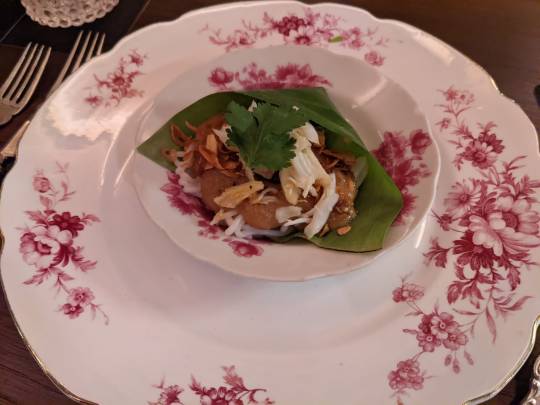
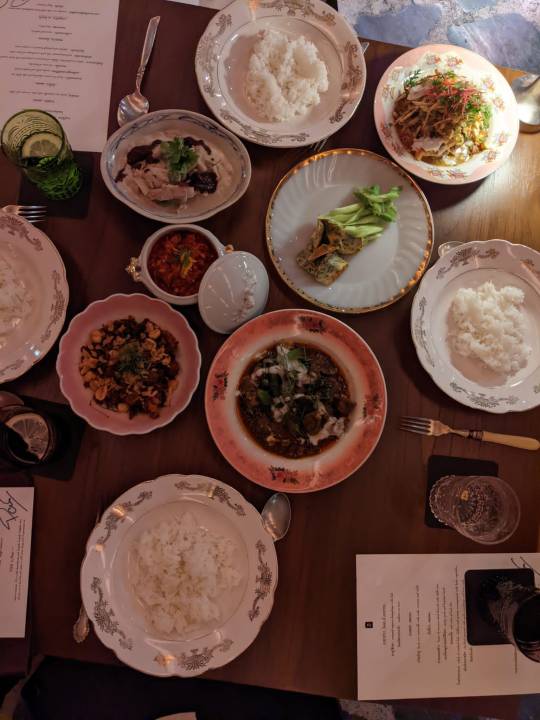
Samlor
Samlor was spectacular. This was perhaps the best meal of my trip. Sadly, at the moment they don't have a tasting menu available on a regular basis. But once a month they do a special tasting menu pop-up, so booking on one of those nights is key. As Chef Joe said at the end of the meal, this isn't a meal of Thai food, but its a meal where each course aims to highlight Thai flavors and ingredients. And the meal did so with such poise and elegance. There was a delicious fish watermelon starter topped with cavier, a clever play on a traditional Thai summer snack. Then a delicious and spicy shrimp tartar, a beautiful oyster which stands out because I find often dressed up oyster dishes mean you dont really taste the oyster, and here you could despite so much going on in the bite. Then there were many other incredible bites, too many to detail, but the highlights for me were a slice of beef in a penang mole that was stunning, a dessert that perhaps needs to be ranked as my favorite of all time, with fried shallots on top of frozen passionfruit, jasmine cream, and kaffir lime. It was so incredible- a combination that shouldn't work, but did, and honestly could easily be included on a Noma menu, and then finally a foie gras ice cream coated in chocolate with caramelized sweet fish sauce. It tasted like the best magnum ice cream you have never had. What I saw in this meal was a chef that is truly brilliant- he understands flavors in a highly sophisticated way, and has excellent technique, and will be blowing up very soon in my view.

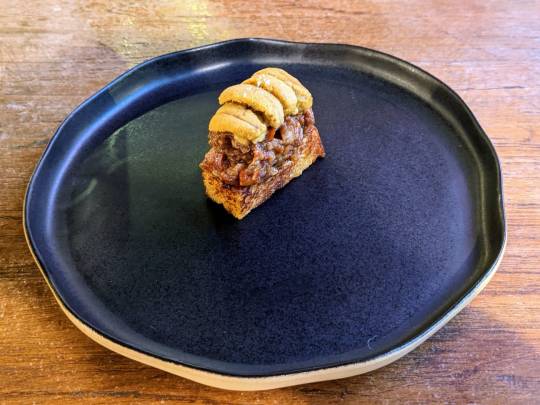
Samrub for Thai
This place is the bomb. Chef Prin is serving the rock-n-roll of Thai food in my view- edgy, funky, punchy, and so much fun to eat. We went twice, and the first time the monthly theme was a Khmer/Isaan inspired menu. There were some stunning bites including baby fried crabs that a month later I keep dreaming about snacking on, a fish soup so unbearably fragrant, and a coconut fish relish that I wanted to bottle it up and keep it as a daily snack to smear on toast. On our second trip, much of the meal centered on clams, a range of different ones all of excellent quality, and the meal was an equal joy. Chef Prin is a very exciting chef! Don't miss their rum steeped in local olives.

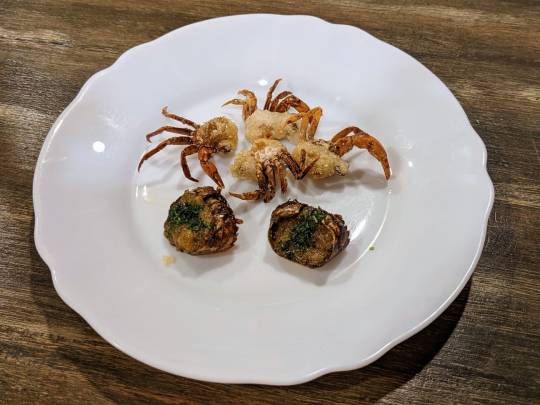

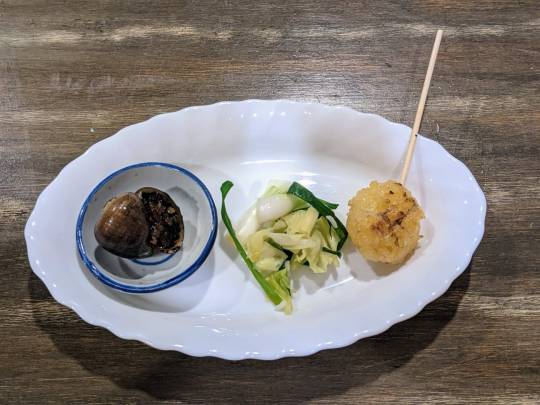
Haawm
Getting a booking here is tough, getting to Chef Dylan’s house is far, and it’s largely BYOB. But once you arrive you can tell it will be worth it. Chef Dylan has a great 60s vibe going through the house that meshes with the menu, which is made up of vintage 60s and 70s Thai recipes. Our meal was fabulous, with each dish packing a punch. Some favorites were a burnt pineapple, prawn and chili jam salad, a shrimp relish with crab and gooseberries, and a stir-fry cabbage with duck egg and orange chilies. The opening bite of rose apple with prickly ash relish was also superb. If you are in BKK, you should be pulling every string you can to get a seat here.



Sra Bua by KIIN KIIN
A very uneven meal. The starters were amazing, a parade of very elevated Thai street snacks, served with lots of showmanship (which I thought was a tad much but they made it work). And many of these bites really were better than the original. Some less so though- their tom yum was definitely not the best we had in Thailand, and the shrimp dim sum bites weren’t great. Then we got to the plated dishes, and there was a scallop dish that was plain weird, and a fish tom kha that was ok (though I thought odd they served a tom yum and a tom kha in the same meal, a bit too much soupiness for my liking), and a very unsuccessful beef carpaccio. But one highlight among the plated dishes was a fabulous crab curry. For dessert there were two nice ice creams, the coconut one was good but nothing compared to JING JING Ice-cream Bar and Café in my view, and they were served next to crepes that were not made fresh to order, with an odd mix of toppings that were flambeed table-side. This really was weird, in the country of some of my favorite desserts in the world, to get a not very good sort of crepe suzette… Not sure if I would recommend this meal to others.


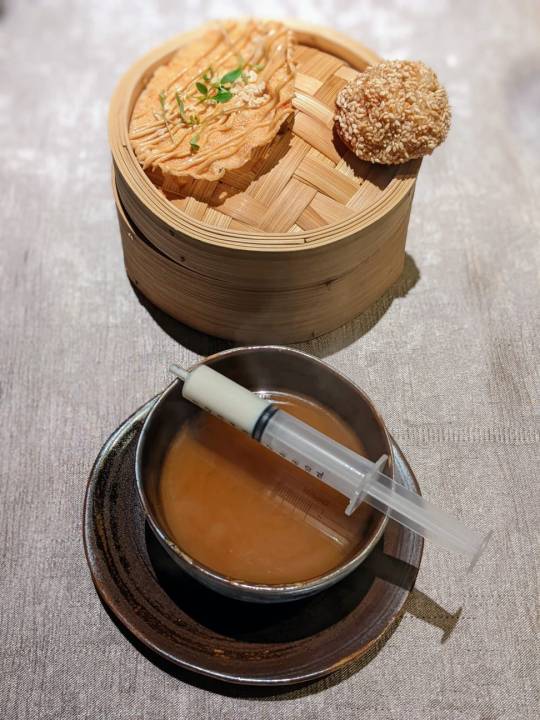

Wana Yook
This was an uneven meal. There were some exceptional bites. There was a burnt coconut dessert that is the best dessert we have had this entire trip. The final main course with different salads, curries and rices with two different cured egg yolks and crispy fried egg whites was also fabulous. And his reconceptualization of Tom Kha Gai was amazing. Overall highlights were the way he treated the proteins, in every dish they were prepared to perfection, and his featuring of so many different types of rice. However, some dishes fell quite flat. And the overall setup of the restaurant, the lighting, interior design and choice of music were a bit off-putting.

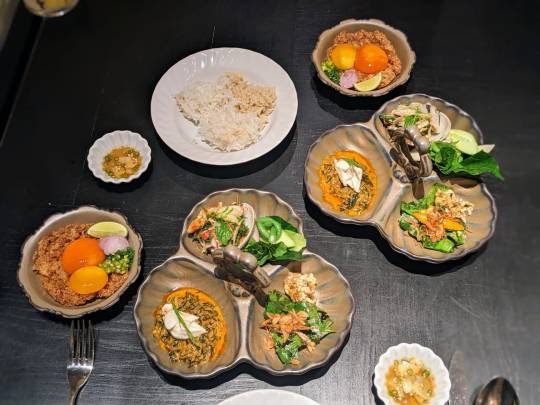


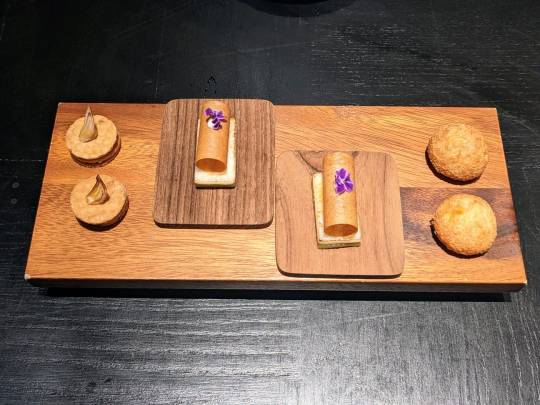


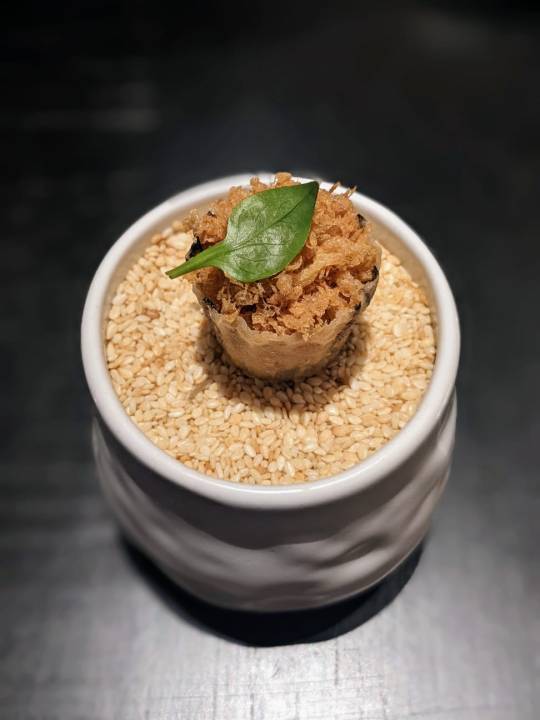
Nusara
This was a bit of a strange meal for me. First, I didn't like our table setup, we felt a bit like we were seated in a sort of hallway. But the first bites came out and they were fantastic, including a beautiful and fragrant crab curry. But the mains were a let down- a beef cheek that was not very tender, and a wagyu beef course where there were so many herbs used in the dish that you lost the delicate beef flavor completely. Overall a mixed experience.






Le Du
Similar to Nusara, at Le Du we had some stunning bites including a beautiful soft-shell crab curry, a fermented rice noodle and savory ice cream bite, an amazing Thai risotto, and a beautifully complex cucumber and fish ceviche. But other bits were less exciting and it didn't feel like a meal that had a thoughtful progression to it, as opposed to a string of individual dishes.
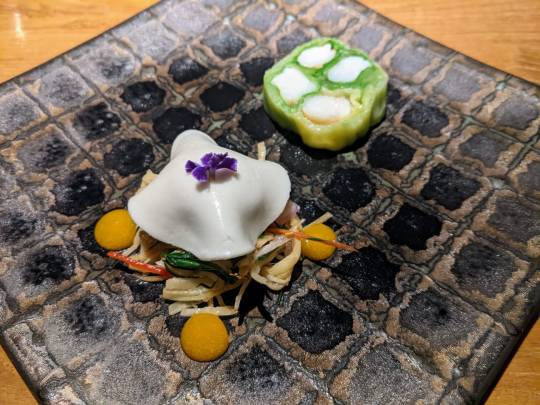
Bo.lan
What a let down. I don't know if the issue is that we went here for a pop-up after they have been closed for months, and don't have the full kitchen staff working, but the meal was more expensive than almost any other we had in Bangkok and the food really just wasn't exceptional. Besides an opening bite (special rice with a special coconut jaggery powder on top) and a pre-dessert bite (a rice and coconut bite), nothing else was exceptional, nor was it even particularly good. And while that might just be a taste issue, which I can acknowledge, what bothered me the most was the quality of what was being served, given the price. For example there was a beef curry, and in it, all we got were hunks of fat, or hunks of chewy beef that were attached to hunks of fat. There was a prawn salad, with prawns that were not very nice, etc. Again, while I accept that maybe my taste is different to the chef's, I dont accept bad quality beef and seafood when the price tag on a meal is that exceedingly high.
0 notes
Photo

i’m only doing shit that’s gonna make me elevate. #moniexplores #moniwore (at KIIN Lao & Thai Eatery) https://www.instagram.com/p/CbJSNjEsKiu/?utm_medium=tumblr
0 notes
Photo

My core partner , my lover , my best friend , my salty mate , my family, my fellow poet , my beluga , my joy ... thank you for a fantastic birthday month/week/day. I hope everyone finds someone to look at like I look at @brownroundboi !! #qtpoc #queer #migrant #api #latinx #pilipinx #artist #queerlove #gendernonconforming #gendernonbinary #femmesofcolorvisibility #femme #artist #poet #writersofcolor (at Kiin Thai Eatery)
#migrant#femmesofcolorvisibility#queer#writersofcolor#qtpoc#pilipinx#api#gendernonbinary#poet#latinx#femme#queerlove#gendernonconforming#artist
7 notes
·
View notes
Video
youtube
Looking for where to eat in Toronto for Thai food? Kiin is one of the best restaurants in Toronto for Royal Thai cuisine. Chef Nuit Regular demonstrated one of Kiin's most popular dishes, Khao Yum, a Southern Thai rice salad that uses Thai superfood riceberry rice. Such a colorful rice dish!
0 notes
Text
There’s never just one ant
So there's a great Thai restaurant in my neighborhood called Kiin. Yesterday, I searched for their website to order some takeout. Here's the Google result.
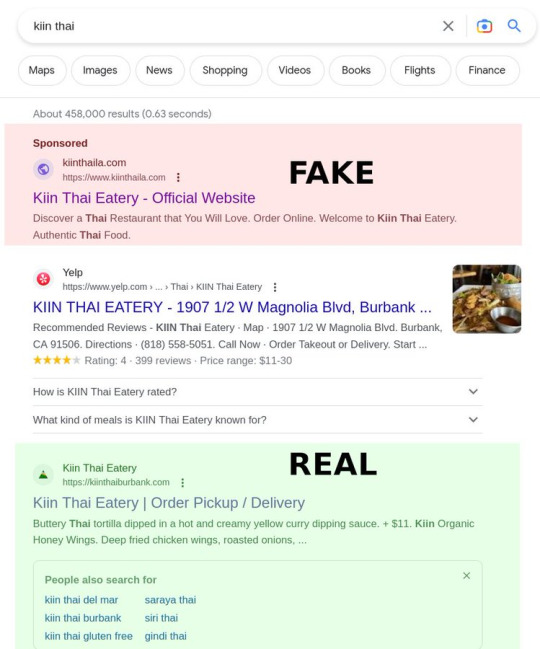
That top result (an ad)? It's fake. It goes to https://kiinthaila.com, which is NOT the website for Kiin.
The *third* result is real: https://kiinthaiburbank.com
Fake site:
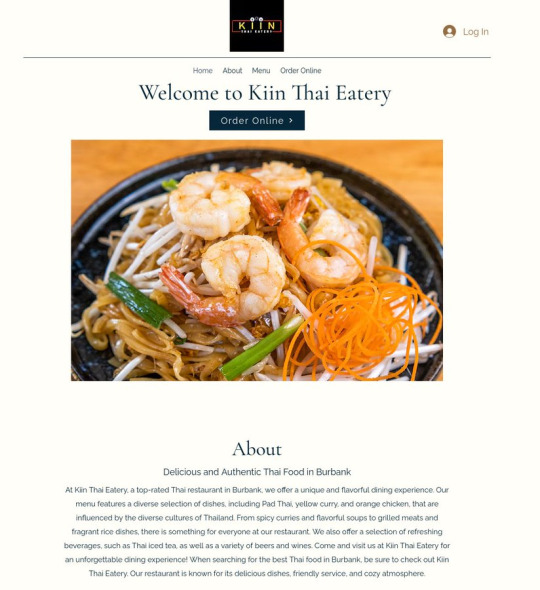
Real site:
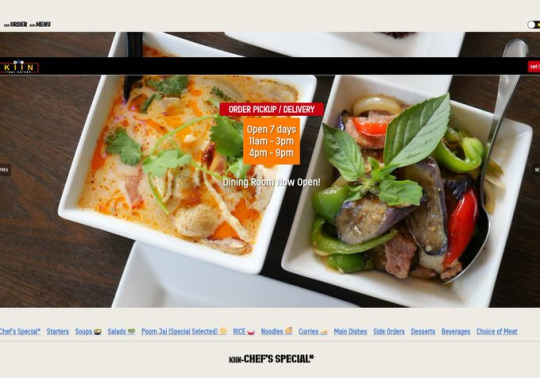
I got duped. I placed an order with the fake site. The fake site then placed the order - in my name! - with the real site, having marked up the prices by 15%. Kiin clearly knows they're doing this (presumably by the billing data on the credit card the fakesters use to place the order). They called me within minutes to tell me they'd cancelled the fakesters' order.
I could still come pick it up, but I'd have to pay them, and cancel the payment to the fakesters with Amex. Actually, as it turns out, I have to cancel TWO payments, because the fakesters DOUBLE-charged me.
Here's what that charge looks like on my Amex bill. See that phone number? (415) 639-9034 is the number for Wix, who provides the scammers' website.

How the actual FUCK did these obvious scammers get an Amex merchant account in the name of "KIINTHAILA" by after supplying the phone number for a website hosting company? What is Amex's KYC procedure? Do they even call the phone number?
And why the actual FUCK is Google Ads accepting these scam artists' ads for a business that they already have a knowledge box for?! Google KNOWS what the real KIIN restaurant is, and yet they are accepting payment to put a fake KIIN listing two slots ABOVE the real one.
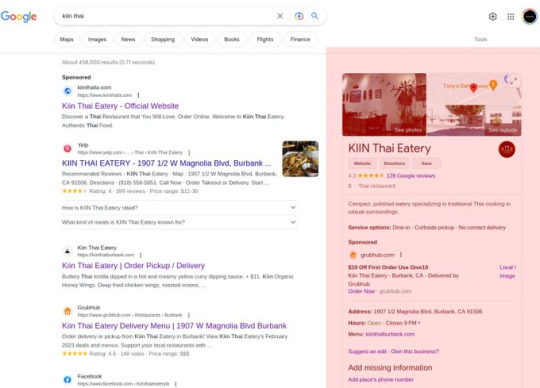
To be fair to these scammer asshole ripoff creeps who are trying to steal from my local mom-and-pop, single location Thai eatery, they're just following in the shoes of Doordash and Uber Eats, who did the same thing to hundreds (thousands?) of restaurants during lockdown.
Doug Rushkoff says that the ethic of today's "entrepreneur" is to “Go Meta” - don't provide a product or a service, simply find a way to be a predatory squatter on a chokepoint between people who do useful things and people who use those things.
These parasites have turned themselves into landlords of someone else's home, collecting rent on a property they don't own and have no connection to.
There's NEVER just one ant. I guaran-fucking-tee you that these same creeps have 1,000 other fake Wix websites with 1,000 fake Amex merchant accounts for 1,000 REAL businesses, and that Google has sold them ads for every one of them. Amex and Google and Wix should be able to spot these creeps FROM ORBIT. Holy shit do we live in the worst of all possible timelines. We have these monopolist megacorps that spy on and control everything we do, wielding the most arbitrary and high-handed authority.
And yet they do NOT ONE FUCKING THING to prevent these petty scammers from using their infra as force-multipliers to let them steal from every hungry person patronizing every local restaurant.
I mean, what's the point of letting these robber-barons run the entire show if they're not even COMPETENT?
ETA: Dinner was delicious
11K notes
·
View notes
Photo

#whereverimayroam @ Kiin Thai-Viet Eatery Yes, I like yaca coladas... (en Kiin Thai-Viet Eatery) https://www.instagram.com/p/CCzTWURn4l3/?igshid=x29wx6dt27vo
0 notes
Text
Giới game thủ “săn lùng” màn hình gaming LG UltraGear 144Hz 1ms
Dòng màn hình LG UltraGear có 7 model, nhưng trong đó có 3 model được ưa chuộng nhất là 27GL850 (27 inch), 34GL850 (34 inch) và 38GN950 (38 inch). 3 model màn hình này là sự kết hợp của mọi tính năng mà một game thủ ao ước, với mức giá rất hợp lý lần lượt là 16.000.000, 26.500.000, 41.900.000 đồng.
Màn hình Nano IPS 144Hz 1ms đầu tiên trên thế giới – Vũ khí của những nhà vô địch
Với các game thủ, điểm “ăn tiền” nhất của dòng màn hình LG UltraGear là tần số quét và tốc độ phản hồi. Đây là một trong những tiêu chí được “xăm soi” khi cho các màn hình “đọ súng”, bởi nó chính là yếu tố ảnh hưởng cực lớn đến hiệu quả thao tác và kết quả trận đấu, giúp nâng tầm trải nghiệm game lên một tầm cao mới.
LG UltraGear được các game thủ “nhớ mặt đặt tên” bởi đây là dòng màn hình Nano IPS đầu tiên trên thế giới đạt tốc độ phản hồi chỉ 1ms. Hiểu một cách đơn giản, tốc độ phản hồi là tốc độ chuyển từ màu này sang màu khác của các điểm ảnh trên màn hình. Tốc độ phản hồi càng cao, hình ảnh chuyển động càng sắc nét, ít nhòe. Đa số các màn hình chơi game có tốc độ phản hồi dưới 5ms. Con số ấn tượng 1ms giúp màn hình LG UltraGear hiển thị được những hình ảnh chuyển động tốc độ cao thực sự sắc nét, mượt mà giống như trong thực tế.
Song song với tốc độ phản hồi ấn tượng, LG UltraGear có tần số quét 144Hz. Nếu đã từng trải nghiệm chơi game trên một chiếc màn hình gaming có tần số quét 120Hz, bạn sẽ thấy cực kỳ khác biệt. Nhất là khi chơi các tựa game tốc độ cao như FPS.

Màn hình LG UltraGear có tần số quét và tốc độ phản hồi đạt tiêu chuẩn của màn hình dành cho các giải đấu eSport lớn
Hoàn hảo đến từng khung hình
Thay vì tấm nền TN hay VA buồn tẻ, LG UltraGear sử dụng tấm nền Nano IPS. IPS vốn là công nghệ màn hình được ưa chuộng nhờ góc nhìn siêu rộng và khả năng tái tạo hình ảnh tuyệt đẹp, sống động từ mọi góc nhìn. Ở dòng UltraGear, tấm nền IPS còn được nhúng thêm lớp tinh thể nano, có độ bao phủ 98% không gian màu DCI-P3, đạt tiêu chuẩn chuyên nghiệp của ngành điện ảnh. Nhờ đó, người chơi có thể trải nghiệm cảm giác là trung tâm của trận đấu với không gian game sống động đúng như ý đồ của các nhà phát triển trò chơi.

LG UltraGear mang lại những trải nghiệm hình ảnh mãn nhãn cho các game thủ
Là dòng màn hình gaming cao cấp, tất nhiên LG UltraGear cũng hỗ trợ 2 công nghệ G-Sync và FreeSync 2 thông qua cổng Display Port giúp điều chỉnh linh động tần số quét của màn hình và giới hạn mức FPS mà PC xuất ra, đồng bộ tần số quét với mức FPS. Khi “thực chiến” trên UltraGear, người chơi sẽ được tận hưởng trải nghiệm chơi game mượt mà, không có hiện tượng rách hình, giật hình, độ trễ gần như không có.
Thêm cá tính cho “vương quốc game” của riêng mình
Không chỉ chinh phục game thủ bằng những tính năng hấp dẫn, LG UltraGear còn ghi điểm ở thiết kế đậm chất gaming với màn hình viền siêu mỏng, chân đế vát cắt với những đường nét tối giản, mạnh mẽ. Đặc biệt, giới game thủ “săn lùng” LG UltraGear vì đây là dòng màn hình game duy nhất theo đuổi thiết kế công thái học (ergonomics trend). Chân đế đa năng có trục xoay giúp game thủ dễ dàng tùy chỉnh độ cao, góc nhìn cho phù hợp với tư thế ngồi.

Thiết kế công thái học của LG UltraGear giúp game thủ thoải mái tận hưởng trọn vẹn các trò chơi tốc độ nhanh trong nhiều giờ liền
Chiều lòng các game thủ cá tính, LG UltraGear còn được trang bị dải đèn hiệu ứng LED đặc biệt Sphere Lighting. Người chơi có thể tùy chỉnh dải màu sắc theo ý thích để tô điểm cá tính cho “vương quốc game” của mình.
Mang đến những trải nghiệm “đỉnh” và “đã” nhất, LG UltraGear không chỉ là mơ ước của các game thủ, mà còn là lựa chọn của các cyber game cao cấp. Mới đây, tập đoàn Afreeca TV đình đám của Hàn Quốc đã lựa chọn dòng màn hình LG UltraGear để trang bị cho hệ thống 100 Cyber game cao cấp mang thương hiệu Kiin Centre vừa đổ bộ Việt Nam, với cơ sở đầu tiên vừa khai trương tại Hapulico Vũ Trọng Phụng, Thanh Xuân, Hà Nội.

LG UltraGear là lựa chọn “vàng” giúp các phòng game thu hút người chơi và tối ưu vốn kinh doanh nhờ chất lượng cao cấp và mức giá hợp lý
Bill Gates thức đến 4h sáng để viết trò chơi máy tính đầu tiên trên thế giới, bị nhân viên Apple cà khịa là ‘trò chơi đáng xấu hổ nhất’
Nguồn: genk
Bài viết Giới game thủ “săn lùng” màn hình gaming LG UltraGear 144Hz 1ms đã xuất hiện đầu tiên vào ngày Đồ Chơi Công Nghệ.
source https://dochoicongnghe.com.vn/gioi-game-thu-san-lung-man-hinh-gaming-lg-ultragear-144hz-1ms-17675.html
0 notes
Photo

Second yummy dinner of the holiday season with my sister! Enjoying yummy Thai food in memory of Terri Murphy’s birthday! #thaifood #latergram (at Kiin Kiin Thai Eating Room) https://www.instagram.com/p/B6eCuEjpLEW/?igshid=g8dathsdgg1h
0 notes
Text
2019 Bangkok Trip ✤ 曼谷回鄉完夢之旅 ✤ Day 4 : 最後早餐 + 一星 Paste 午餐 + 回港
很快來到最後一篇曼谷遊記:由於訂了 17:05 DMK/21:05 HKG 的回程機票,這天吃完一星 Paste 午餐就差不多要出發到機場,行程不多,因此是四天中最簡短的一篇!

最後一天可以睡到自然醒,而一起床後又是有各款新鮮水果、鮮打果汁及豐富早餐伺候,感覺真心幸福!那麼喜歡到泰國旅遊,新鮮又吸引的水果絕對是個大大的加分位~

由於還有米芝蓮一星午餐的約會,所以這天沒敢吃太飽,約七成飽就回房收拾兼欣賞最後一回藍天白雲下的市景。考慮這裡地點便利,房間及早餐又棒,其實再有特價也會再訂來住!

對了,我們的客廳其實也可以望到泳池,最後也分享一張藍天下的泳池照吧~收拾妥當退房後,我們又乘不會塞車的 BTS,由 Nana 搭兩個站去 Chit Lom 嘆米芝蓮囉!

Paste Address : 999 Phloen Chit Rd, Khwaeng Lumphini, Khet Pathum Wan, Krung Thep Maha Nakhon 10330, Thailand/999 ถนน เพลินจิต แขวง ลุมพินี เขต ปทุมวัน กรุงเทพมหานคร 10330 Facebook:Paste Bangkok Thai Cuisine

Paste 位於美美的 Gaysorn Village 三樓,非常方便易達。以白色為主的格調高雅,靠窗的位置可享受充分的自然光,令拍的每幅食物都變得異常吸引;整體味道不錯,感覺比 Day 1 晚餐的一星 Saneh Jaan 要好,但與同樣是一星的台北 Longtail 比就差遠了~


位處高貴地段,午市 Tasting Menu 2,000銖/位起,也可以散點;由於主菜不太合意,這天兩口子決定散點心儀的美食。首先是免費贈送的碟豆花飲料及 Amuse bouche,是件蟹肉紫菜多士,賣相非常精緻,味道也OK的~

開了一支 Still water 後,老公又點了一杯 Manhattan,這款 cocktail 頗烈的,他喝了一半左右已經滿臉通紅,超可愛的!


頭盤決定照跟 Tasting Menu 來點,首先是 Watermelon, ground salmon with fried shallots and roasted galangal powder,菜式很美,西瓜與三文魚、乾蔥等的食材組合味道也不錯,但個人還是更喜歡西瓜配搭大蝦或辣汁牛肉,效果會驚艷很多(被寵壞了的舌頭)~

接著是 Roasted duck, nutmeg & sawtooth coriander on rice crackers,同樣是脆口的小吃,這個比免費送的 Amuse bouche 還沒那麼好吃,每人兩件又有點多,唯一抵讚是非常上鏡... 雖然如此,如是散點還是不建議選啦!

最後一款是網上餐單已經找不到,類似粥的奇怪頭盤;又是賣相OK,但溫溫吞吞絕不好吃的出品,在三款頭盤是最差的一款,被剔出餐單有理。


吃過一般的頭盤後,自選的主菜卻頗有驚喜。這天不想吃辣,放棄咖哩點了 Lon of spanner crab, Nan province salted duck egg, fresh coconut milk, hairy eggplant & lime leaf,鮮甜的蟹肉與椰奶擦出了美味動人的火花,那溏心的鹹蛋黃更是我吃過最美妙的出品,加上超美的伴碟(不只是裝飾,其中的霧蓮及蘋果片都可以吃用),兩口子都非常滿意!

牛魔老公則點了 12 hours braised Australian beef rib with long pepper, roasted tomatoes & mushroom soy sauce,這個味道合乎預期,淨食稍有點濃膩,配上香口米飯則剛剛好。

其實我還想到附近逛一逛,所以主菜後沒點甜品了,但餐廳埋單還是送上印了店名的朱古力甜點作為 Peti Fours。埋單 6,250銖,差不多格局個人更推介文華東方2星的 Le Normandie,味道更好也更抵食~

午餐後到了隔壁 Gaysorn Food Village 逛,想去 ChaTraMue 買杯泰式奶茶軟雪糕,好可惜當日正好沒貨... 時間不多了,最後買下少量零食給兩兄妹(這次 shopping 的時間真心很少....)又要趕搭 BTS 回酒店,取了行季就搭的士去機場了~


很感恩在曼谷的這幾天都一直天晴,直到我們上了車才開始下雨.... 去到機場,DMK 是沒有美味的 King Power 芒果糯米飯買的,還在入禁區前找到一間 Mango Coco 的店,出品有過之而無不及,價錢一樣180銖,但份量更大兼有買三送一,糯米飯迷要留意~

去到機場,已收到航班 Delay 通知,所以我們慢慢在禁區外/內的 VAT Refund 櫃台排隊退稅;換了平時,就不會花時間雙重排隊去拿回區區一百幾十了。

更慘是航班一再延期至9:00pm(原本這時間差不多抵港了!),兩口子唯有買些餐點吃,並在擠逼又悶熱的候機區呆呆苦等... 還好上機後一切都很順利,旅程就此完滿結束。

雖然最後 Delay flight 實在不爽,但還是無損對曼谷的深深喜愛,只是下次回鄉真的不能再搭 AirAsia 了!=P
延伸閱讀: 2019 Bangkok Trip Summary ✤ 曼谷回鄉完夢之旅 ✤ 2019 曼谷回鄉完夢之旅 ✤ Day 1 : 出發 + 水門雞飯 + Hyatt Regency + 一星 Saneh Jaan 晚餐 2019 曼谷回鄉完夢之旅 ✤ Day 2 : 水上市場 + 鐵道市場 + Spectrum Lounge & Bar + Let's Relax 2019 曼谷回鄉完夢之旅 ✤ Day 3 : Market Café + The Best Of Noodle Boat + Erawan Tea Room + Let's Relax + Apsara by Banyan Tree {二人世界篇} 2017 Bangkok Trip Summary ✮ 曼谷摘星充電之旅 2016 七週年銅婚 ஐ Copper Wedding Bangkok Trip ஐ 曼谷之旅總結 2015 六週年鐵婚曼谷之旅 ஐ Iron Wedding Bangkok Trip ஐ 旅程總結 {親子樂悠篇} 2018 Phuket Trip ☼ 布吉親子玩樂之旅 ☼ Summary 總結篇
2017 Hua Hin Trip ☼ 華欣親子玩水之旅 ☼ Summary 總結篇
2016 夏 ❉ Chiang Mai Family Trip 清邁親子之旅 ❉ 總結篇
{曼谷米芝蓮}
2星 Gaggan 2星 Le Normandie at Mandarin Oriental, Bangkok 1星 Nahm 1星 Sra Bua by Kiin Kiin 1星 L’Atelier de Joël Robuchon – Bangkok 1星 Saneh Jaan 1星 Paste
** 想得知最新飲食情報,可追蹤 甜魔媽媽;欲得知甜魔一家消息,就追蹤 Matthew and Chloe 吧~~
飲食資訊由熱新聞提供 原文連結: 2019 Bangkok Trip ✤ 曼谷回鄉完夢之旅 ✤ Day 4 : 最後早餐 + 一星 Paste 午餐 + 回港 更多相關內容

更多元朗食記:The Backstreet Kitchen + 稚 + Outback Steakhouse...

Yan Lo 甜魔媽媽的新天地,在這裡與大家分享美食、育兒,以及旅遊資訊~~~24小時為你介紹不同的餐廳,各國美食精選等!
0 notes
Video
youtube
Looking for where to eat in Toronto, Ontario? Kiin is one of the best Thai restaurants in Toronto. The prettiest rice dish I've seen is Khao Yum at Kiin Toronto by Chef Nuit Regular. Watch how they explain and mix the Khao Yum table-side for you.
0 notes
Text
This is your brain on fraud apologetics
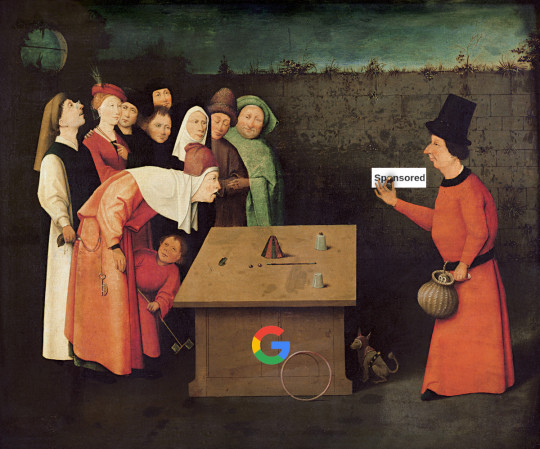
In 1998, two Stanford students published a paper in Computer Networks entitled “The Anatomy of a Large-Scale Hypertextual Web Search Engine,” in which they wrote, “Advertising funded search engines will be inherently biased towards the advertisers and away from the needs of consumers.”
https://research.google/pubs/pub334/
If you’d like an essay-formatted version of this post to read or share, here’s a link to it on pluralistic.net, my surveillance-free, ad-free, tracker-free blog:
https://pluralistic.net/2023/02/24/passive-income/#swiss-cheese-security
The co-authors were Lawrence Page and Sergey Brin, and the “large-scale hypertextual web search-engine” they were describing was their new project, which they called “Google.” They were 100% correct — prescient, even!
On Wednesday night, a friend came over to watch some TV with us. We ordered out. We got scammed. We searched for a great local Thai place we like called Kiin and clicked a sponsored link for a Wix site called “Kiinthaila.com.” We should have clicked the third link down (kiinthaiburbank.com).
We got scammed. The Wix site was a lookalike for Kiin Thai, which marked up their prices by 15% and relayed the order to our local, mom-and-pop, one-branch restaurant. The restaurant knew it, too — they called us and told us they were canceling the order, and said we could still come get our food, but we’d have to call Amex to reverse the charge.
As it turned out, the scammers double-billed us for our order. I called Amex, who advised us to call back in a couple days when the charge posted to cancel it — in other words, they were treating it as a regular customer dispute, and not a systemic, widespread fraud (there’s no way this scammer is just doing this for one restaurant).
In the grand scheme of things, this is a minor hassle, but boy, it’s haunting to watch the quarter-century old prophecy of Brin and Page coming true. Search Google for carpenters, plumbers, gas-stations, locksmiths, concert tickets, entry visas, jobs at the US Post Office or (not making this up) tech support for Google products, and the top result will be a paid ad for a scam. Sometimes it’s several of the top ads.
This kind of “intermediation” business is actually revered in business-schools. As Douglas Rushkoff has written, the modern business wisdom reveres “going meta” — not doing anything useful, but rather, creating a chokepoint between people who do useful things and people who want to pay for those things, and squatting there, collecting rent:
https://rushkoff.medium.com/going-meta-d42c6a09225e
It’s the ultimate passive income/rise and grind side-hustle: It wouldn’t surprise me in the least to discover a whole festering nest of creeps on Tiktok talking about how they pay Mechanical Turks to produce these lookalike sites at scale.
This mindset is so pervasive that people running companies with billions in revenue and massive hoards of venture capital run exactly the same scam. During lockdown, companies like Doordash, Grubhub and Uber Eats stood up predatory lookalike websites for local restaurants, without their consent, and played monster-in-the-middle, tricking diners into ordering through them:
https://pluralistic.net/2020/09/19/we-are-beautiful/#man-in-the-middle
These delivery app companies were playing a classic enshittification game: first they directed surpluses to customers to lock them in (heavily discounting food), then they directed surplus to restaurants (preferential search results, free delivery, low commissions) — then, having locked in both consumers and producers, they harvested the surplus for themselves.
Today, delivery apps charge massive premiums to both eaters and restaurants, load up every order with junk fees, and clone the most successful restaurants out of ghost kitchens — shipping containers in parking lots crammed with low-waged workers cranking out orders for 15 different fake “virtual restaurants”:
https://pluralistic.net/2020/12/01/autophagic-buckeyes/#subsidized-autophagia
Delivery apps speedran the enshittification cycle, but Google took a slower path to get there. The company has locked in billions of users (e.g. by paying billions to be the default search on Safari and Firefox and using legal bullying to block third party Android device-makers from pre-installing browsers other than Chrome). For years, it’s been leveraging our lock-in to prey on small businesses, getting them to set up Google Business Profiles.
These profiles are supposed to help Google distinguish between real sellers and scammers. But Kiin Thai has a Google Business Profile, and searching for “kiin thai burbank” brings up a “Knowledge Panel” with the correct website address — on a page that is headed with a link to a scam website for the same business. Google, in other words, has everything it needs to flag lookalike sites and confirm them with their registered owners. It would cost Google money to do this — engineer-time to build and maintain the system, content moderator time to manually check flagged listings, and lost ad-revenue from scammers — but letting the scams flourish makes Google money, at the expense of Google users and Google business customers.
Now, Google has an answer for this: they tell merchants who are being impersonated by ad-buying scammers that all they need to do is outbid them for the top ad-spot. This is a common approach — Amazon has a $31b/year “ad business” that’s mostly its own platform sellers bidding against each other to show you fake results for your query. The first five screens of Amazon search results are 50% ads:
https://pluralistic.net/2022/11/28/enshittification/#relentless-payola
This is “going meta,” so naturally, Meta is doing it too: Facebook and Instagram have announced a $12/month “verification” badge that will let you report impersonation and tweak the algorithm to make it more likely that the posts you make are shown to the people who explicitly asked to see them:
https://www.vox.com/recode/2023/2/21/23609375/meta-verified-twitter-blue-checkmark-badge-instagram-facebook
The corollary of this, of course, is that if you don’t pay, they won’t police your impersonators, and they won’t show your posts to the people who asked to see them. This is pure enshittification — the surplus from users and business customers is harvested for the benefit of the platform owners:
https://pluralistic.net/2023/01/21/potemkin-ai/#hey-guys
The idea that merchants should master the platforms as a means of keeping us safe from their impersonators is a hollow joke. For one thing, the rules change all the time, as the platforms endlessly twiddle the knobs that determine what gets shown to whom:
https://doctorow.medium.com/twiddler-1b5c9690cce6
And they refuse to tell anyone what the rules are, because if they told you what the rules were, you’d be able to bypass them. Content moderation is the only infosec domain where “security through obscurity” doesn’t get laughed out of the room:
https://doctorow.medium.com/como-is-infosec-307f87004563
Worse: the one thing the platforms do hunt down and exterminate with extreme prejudice is anything that users or business-customers use to twiddle back — add-ons and plugins and jailbreaks that override their poor choices with better ones:
https://www.theverge.com/2022/9/29/23378541/the-og-app-instagram-clone-pulled-from-app-store
As I was submitting complaints about the fake Kiin scam-site (and Amex’s handling of my fraud call) to the FTC, the California Attorney General, the Consumer Finance Protection Bureau and Wix, I wrote a little Twitter thread about what a gross scam this is:
https://twitter.com/doctorow/status/1628948906657878016
The thread got more than two million reads and got picked up by Hacker News and other sites. While most of the responses evinced solidarity and frustration and recounted similar incidents in other domains, a significant plurality of the replies were scam apologetics — messages from people who wanted to explain why this wasn’t a problem after all.
The most common of these was victim-blaming: “you should have used an adblocker” or “never click the sponsored link.” Of course, I do use an ad-blocker — but this order was placed with a mobile browser, after an absentminded query into the Google search-box permanently placed on the home screen, which opens results in Chrome (where I don’t have an ad-blocker, so I can see material behind an ad-blocker-blocker), not Firefox (which does have an ad-blocker).
Now, I also have a PiHole on my home LAN, which blocks most ads even in a default browser — but earlier this day, I’d been on a public wifi network that was erroneously blocking a website (the always excellent superpunch.net) so I’d turned my wifi off, which meant the connection came over my phone’s 5G connection, bypassing the PiHole:
https://pluralistic.net/2022/04/28/shut-yer-pi-hole/
“Don’t click a sponsored link” — well, the irony here is that if you habitually use a browser with an ad-blocker, and you backstop it with a PiHole, you never see sponsored links, so it’s easy to miss the tiny “Sponsored” notification beside the search result. That goes double if you’re relaxing with a dinner guest on the sofa and ordering dinner while chatting.
There’s a name for this kind of security failure: the Swiss Cheese Model. We all have multiple defenses (in my case: foreknowledge of Google’s ad-scam problem, an ad-blocker in my browser, LAN-wide ad sinkholing). We also have multiple vulnerabilities (in my case: forgetting I was on 5G, being distracted by conversation, using a mobile device with a permanent insecure search bar on the homescreen, and being so accustomed to ad-blocked results that I got out of the habit of checking whether a result was an ad).
If you think you aren’t vulnerable to scams, you’re wrong — and your confidence in your invulnerability actually increases your risk. This isn’t the first time I’ve been scammed, and it won’t be the last — and every time, it’s been a Swiss Cheese failure, where all the holes in all my defenses lined up for a brief instant and left me vulnerable:
https://locusmag.com/2010/05/cory-doctorow-persistence-pays-parasites/
Other apologetics: “just call the restaurant rather than using its website.” Look, I know the people who say this don’t think I have a time-machine I can use to travel back to the 1980s and retrieve a Yellow Pages, but it’s hard not to snark at them, just the same. Scammers don’t just set up fake websites for your local businesses — they staff them with fake call-centers, too. The same search that takes you to a fake website will also take you to a fake phone number.
Finally, there’s “What do you expect Google to do? They can’t possibly detect this kind of scam.” But they can. Indeed, they are better situated to discover these scams than anyone else, because they have their business profiles, with verified contact information for the merchants being impersonated. When they get an ad that seems to be for the same business but to a different website, they could interrupt the ad process to confirm it with their verified contact info.
Instead, they choose to avoid the expense, and pocket the ad revenue. If a company promises to “to organize the world’s information and make it universally accessible and useful,” I think we have the right to demand these kinds of basic countermeasures:
https://www.google.com/search/howsearchworks/our-approach/
The same goes for Amex: when a merchant is scamming customers, they shouldn’t treat complaints as “chargebacks” — they should treat them as reports of a crime in progress. Amex has the bird’s eye view of their transaction flow and when a customer reports a scam, they can backtrack it to see if the same scammer is doing this with other merchants — but the credit card companies make money by not chasing down fraud:
https://www.buzzfeednews.com/article/rosalindadams/mastercard-visa-fraud
Wix also has platform-scale analytics that they could use to detect and interdict this kind of fraud — when a scammer creates a hundred lookalike websites for restaurants and uses Wix’s merchant services to process payments for them, that could trigger human review — but it didn’t.
Where do all of these apologetics come from? Why are people so eager to leap to the defense of scammers and their adtech and fintech enablers? Why is there such an impulse to victim-blame?
I think it’s fear: in their hearts, people — especially techies — know that they, too, are vulnerable to these ripoffs, but they don’t want to admit it. They want to convince themselves that the person who got scammed made an easily avoidable mistake, and that they themselves will never make a similar mistake.
This is doubly true for readerships on tech-heavy forums like Twitter or (especially) Hacker News. These readers know just how many vulnerabilities there are — how many holes are in their Swiss cheese — and they are also overexposed to rise-and-grind/passive income rhetoric.
This produces a powerful cognitive dissonance: “If all the ‘entrepreneurs’ I worship are just laying traps for the unwary, and if I am sometimes unwary, then I’m cheering on the authors of my future enduring misery.” The only way to resolve this dissonance — short of re-evaluating your view of platform capitalism or questioning your own immunity to scams — is to blame the victim.
The median Hacker News reader has to somehow resolve the tension between “just install an adblocker” and “Chrome’s extension sandbox is a dumpster fire and it’s basically impossible to know whether any add-on you install can steal every keystroke and all your other data”:
https://mattfrisbie.substack.com/p/spy-chrome-extension
In my Twitter thread, I called this “the worst of all possible timelines.” Everything we do is mediated by gigantic, surveillant monopolists that spy on us comprehensively from asshole to appetite — but none of them, not a 20th century payment giant nor a 21st century search giant — can bestir itself to use that data to keep us safe from scams.
Next Thu (Mar 2) I'll be in Brussels for Antitrust, Regulation and the Political Economy, along with a who's-who of European and US trustbusters. It's livestreamed, and both in-person and virtual attendance are free:
https://www.brusselsconference.com/registration
On Fri (Mar 3), I'll be in Graz for the Elevate Festival:
https://elevate.at/diskurs/programm/event/e23doctorow/
[Image ID: A modified version of Hieronymus Bosch's painting 'The Conjurer,' which depicts a scam artist playing a shell-game for a group of gawking rubes. The image has been modified so that the scam artist's table has a Google logo and the pea he is triumphantly holding aloft bears the 'Sponsored' wordmark that appears alongside Google search results.]
#pluralistic#victim blaming#fraud#going meta#douglas rushkoff#ad-tech#local search#wix#amex#thai food#business#rent-seeking#entrepreneurship#passive income#chokepoint capitalism#platform lawyers
2K notes
·
View notes



